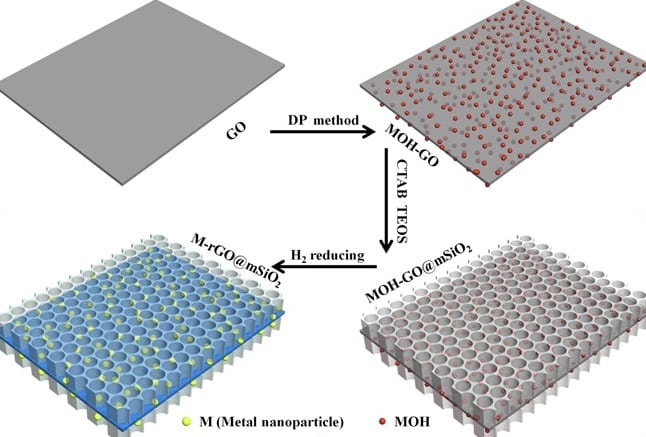Graphene, a one-atom thick sheet of sp2-bonded carbon atoms, has recently attracted tremendous attention from researchers from many fields due to its interesting electrical, thermal, optical, and mechanical properties. For materials chemists, since graphene has an extremely high specific surface area (theoretically up to 2630 m2/g), it is expected to function as an excellent catalyst support material. However, there are two major challenges for such catalyst systems in practical applications: the serious aggregation and restacking of graphene nanosheets due to the strong π–π stacking interactions between GNs, and the low stability of supported nanocatalysts due to the weak interaction between graphene and nanocatalyst as well as the high surface energy of nanocatalysts themselves.
Recently, a team led by Prof. Tierui Zhang at the Technical Institute of Physics and Chemistry, CAS (China) and Prof. Yadong Yin at the University of California, Riverside (USA) have developed a novel strategy to prepare graphene-supported nanocatalysts with exceptional thermo-stability by encapsulating the graphene sheets loaded with metal catalyst nanoparticles within a mesoporous silica sheath.
GN-supported ultrafine Pt nanoparticles (< 2nm) were used as the example to demonstrate how the novel strategy works. After loading the Pt nanoparticles to the GN surface, a mesoporous SiO2 sheath was coated on top of the composite nanostructure through a sol-gel approach. The mesoporous SiO2 sheath can not only avoid the aggregation of GNs by reducing their strong π–π stacking interactions, but also significantly prevent the agglomeration of Pt nanoparticles by providing a physical barrier. According to Dr. Zhang, the as-prepared Pt-GN@SiO2 nanocatalyst shows superior thermal stability at temperatures as high as 700 oC.
Thanks to the mesoporous nature of the silica sheath, the chemical species can diffuse through the sheath and react on the catalytic sites. As demonstrated by the team, the mesoporous SiO2 protected catalysts not only show high catalytic activity and excellent recycling and reusability in hydrogenation of nitrophenol reaction, but also exhibit high stability under long-term, high temperature operation (450 oC) in both water-gas shift reaction and CO oxidation. More importantly, the activity of the poisoned catalysts can be easily recovered by high temperature regeneration, which is very beneficial for industrial applications.
The researchers also believe that their synthetic strategy can be extended to many other catalytic metals, such as Pd, Au and Ru, or other metal oxide sheaths for various industrially valuable catalytic reactions. The combination of graphene templates and the mesoporous oxide encapsulation strategy may provide a robust platform for producing highly robust industrial relevant catalysts.


















